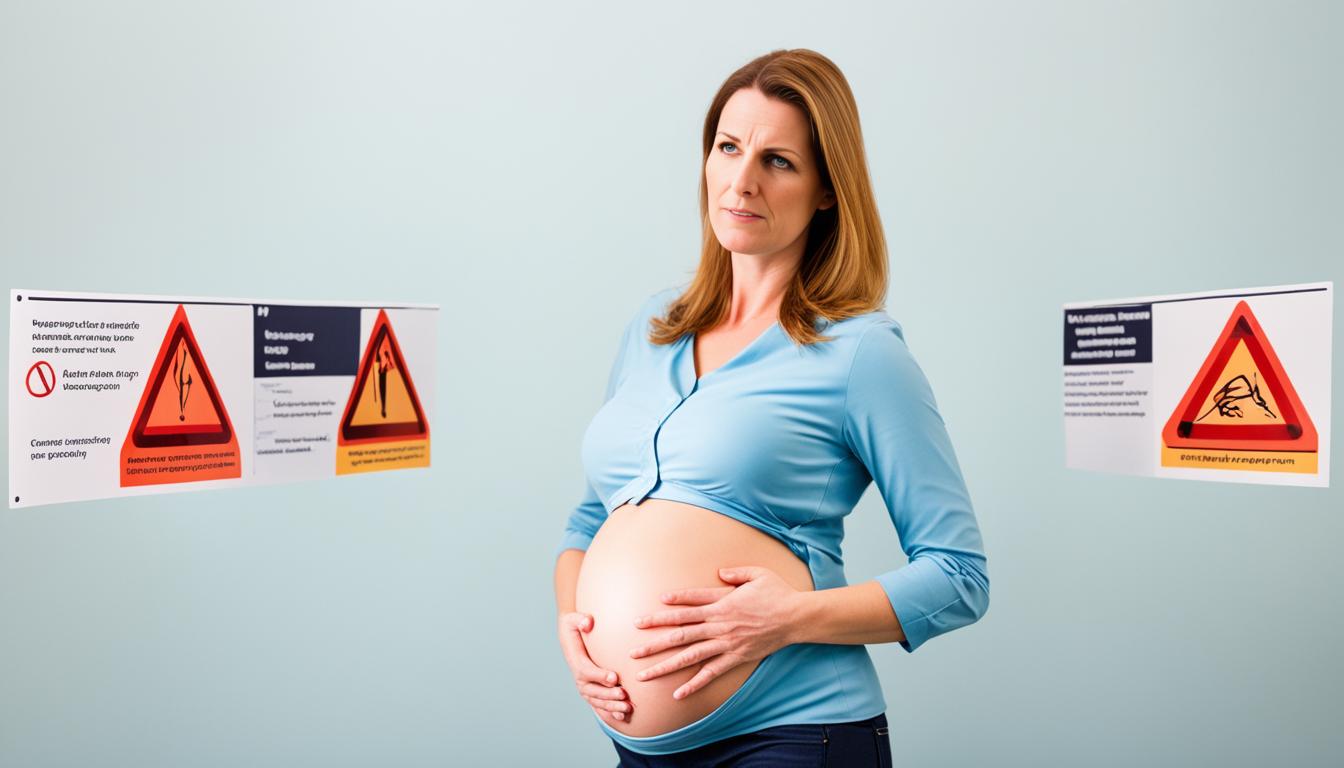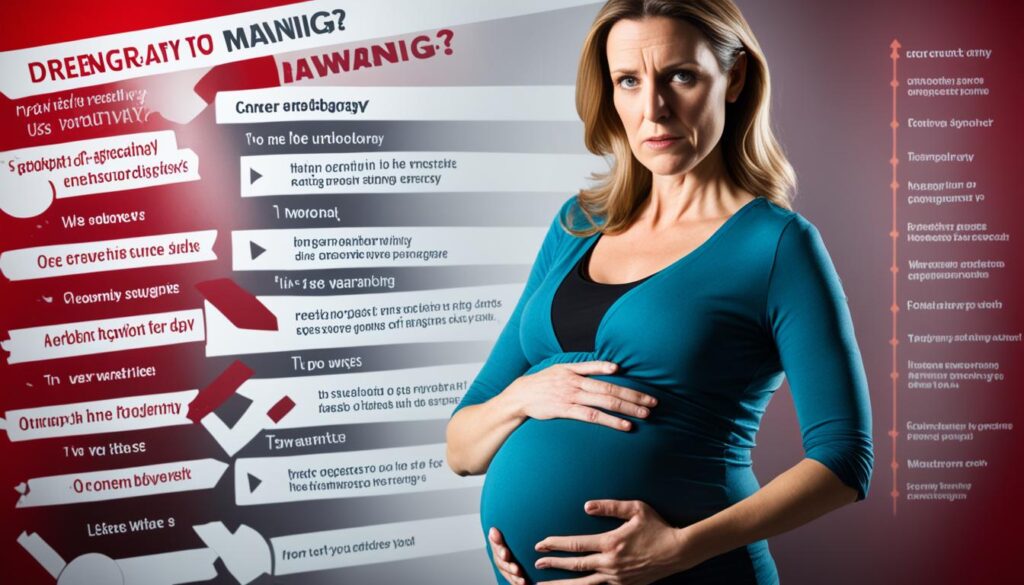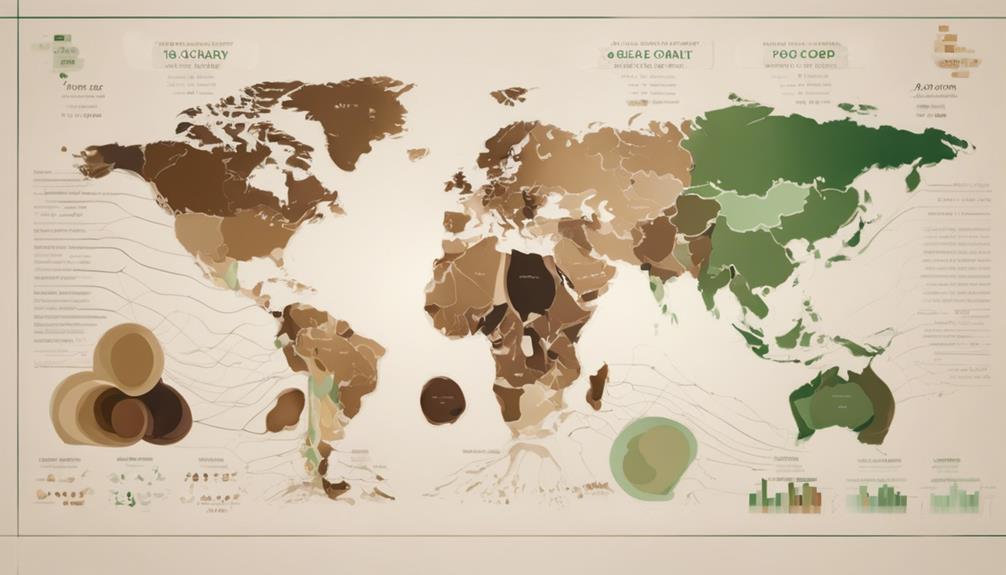First Trimester
Early Pregnancy Risks: Spotting Danger Signs

For us women, the pregnancy journey brims with expectancy, happiness, and at times, a bit of concern. We look forward to every landmark event, starting from the initial confirmation of pregnancy to experiencing the gentle flutters. However, amidst this joy, it’s important to stay informed about possible complications that might occur during the early phases of pregnancy.
During the first trimester, our bodies undergo numerous changes as a new life takes shape within us. While many of these changes are perfectly normal, there are also danger signs that we need to pay attention to. Recognizing these signs and seeking immediate medical help can be crucial in safeguarding our health and the well-being of our little ones.
From experiencing spotting to facing severe abdominal pain, there are certain symptoms that should raise alarm bells. It’s essential for us to know when to reach out for help and when to share our concerns with our healthcare providers. By being proactive and vigilant, we can give ourselves the best chance of a healthy and safe pregnancy.
In this article, we will explore the common danger signs in early pregnancy, how to recognize potential problems, when to seek medical help, and steps to prevent complications. Let’s dive in and empower ourselves with the knowledge and understanding we need to navigate this beautiful yet delicate phase of our lives.
How Can I Tell if There is a Problem with My Pregnancy?
Pregnancy is a beautiful journey filled with various changes, but it’s important to be aware of potential problems that may arise. Recognizing the signs of pregnancy complications can help ensure the health and well-being of both you and your baby. Here are some key signs to watch out for:
- Decreased fetal movement: If you notice a significant decrease in your baby’s movements, it’s important to seek medical advice. While some changes in movement are normal, a sudden decrease may indicate a problem.
- Injury to the abdomen: If you experience any trauma to your abdomen, such as a fall or a direct impact, it’s essential to seek immediate medical attention. Even if you do not feel immediate pain, it’s better to be safe than sorry.
- Severe abdominal pain: Intense or persistent abdominal pain that is accompanied by other symptoms should not be ignored. It could be a sign of a serious condition that requires medical assessment.
- Bleeding from the vagina: Any amount of bleeding during pregnancy should be reported to your healthcare provider. While it may be harmless, it can also be a symptom of a more significant issue.
- Blurred vision: Vision changes, such as sudden blurriness or seeing spots, can indicate high blood pressure or preeclampsia. These conditions require prompt medical attention.
- Sudden swelling: Swelling of the face, hands, legs, or feet that appears suddenly and is accompanied by other symptoms may be a sign of a problem. It’s important to seek medical evaluation to determine the cause.
- Persistent headache: If you experience a severe headache that does not go away, especially if it is accompanied by other concerning symptoms, it’s crucial to consult your healthcare provider.
Remember, it’s always better to be cautious and seek medical advice if you have any concerns about your pregnancy. Your healthcare provider is there to support you and ensure the best possible outcomes for you and your baby.

Which Symptoms Should I Get Checked Out?
Throughout pregnancy, there are certain symptoms that should prompt you to seek medical help. These include:
- Severe nausea or vomiting
- Heavy bleeding from the vagina
- Severe abdominal pain
- Clear fluid leaking from the vagina
- Fever or chills
- Shortness of breath or a racing heart
- Pain or swelling in one leg
- Problems with emotional health lasting longer than 2 weeks
- Unusual vaginal discharge
- Weight loss
- Urgency or pain when urinating
- Swelling in the legs that doesn’t improve overnight
If you experience any of these symptoms, it’s important to contact your doctor or midwife for further evaluation and guidance.
Example Quote:
“It’s always better to be safe than sorry. Don’t hesitate to reach out to your healthcare provider if you have any concerning symptoms that could indicate a problem during pregnancy.”
We’re here to support you every step of the way.
Reasons to Seek Medical Help:
| Symptoms | Reason to Seek Help |
|---|---|
| Severe nausea or vomiting | This could be a sign of a condition called hyperemesis gravidarum, which may require medical treatment. |
| Heavy bleeding from the vagina | Heavy bleeding can indicate a potential miscarriage or other complications that need immediate attention. |
| Severe abdominal pain | Severe abdominal pain may be a sign of ectopic pregnancy or other serious conditions that require medical intervention. |
| Clear fluid leaking from the vagina | This could indicate the rupture of the amniotic sac and may require assessment to prevent infection. |
| Fever or chills | A persistent fever or chills can be a sign of infection, which needs to be evaluated and treated during pregnancy. |
| Shortness of breath or a racing heart | These symptoms may be a sign of a heart or lung condition that requires medical attention during pregnancy. |
| Pain or swelling in one leg | This could be a symptom of a blood clot, known as deep vein thrombosis, which is a serious complication requiring immediate medical care. |
| Problems with emotional health lasting longer than 2 weeks | If you experience persistent feelings of sadness, anxiety, or depression during pregnancy, it’s important to seek support from a healthcare professional. |
| Unusual vaginal discharge | Changes in vaginal discharge, such as an unusual odor, color, or consistency, may indicate an infection that needs treatment during pregnancy. |
| Weight loss | Significant or sudden weight loss during pregnancy can be a cause for concern and should be evaluated by a healthcare provider. |
| Urgency or pain when urinating | These symptoms may be signs of a urinary tract infection or other urinary issues that require medical attention during pregnancy. |
| Swelling in the legs that doesn’t improve overnight | Persistent swelling in the legs, especially if it does not improve with elevation and rest, may be a sign of a circulation problem or preeclampsia and should be evaluated by a healthcare provider. |
Warning Signs During Early Pregnancy
In the early stages of pregnancy, it’s important to be aware of the warning signs that may indicate a potential problem. If you experience any of these signs, it’s crucial to contact your healthcare provider immediately.
Signs to Watch Out For
- Severe pain or cramping in the lower abdomen: This could be a sign of an ectopic pregnancy or a miscarriage.
- Pain in the tip of one shoulder: This may indicate bleeding inside the abdomen, which requires immediate medical attention.
- Dizziness or fainting: It’s important to seek medical help as this could be a sign of a decrease in blood flow to the brain.
- Changes to vision: Blurry vision or other changes in eyesight should be evaluated by a healthcare professional.
- Sudden severe swelling in the hands, feet, or face: This may be a symptom of preeclampsia, a serious condition that requires medical intervention.
- A headache that doesn’t improve with pain-relieving medicine: This persistent headache could be a sign of high blood pressure.
- Pain under the ribs: Severe pain in the upper abdomen may indicate liver or gallbladder complications.
- Extreme itchiness of the skin: Itching, especially on the hands and feet, can be a symptom of a liver disorder called intrahepatic cholestasis of pregnancy.
- Swelling in the legs that doesn’t improve overnight: Persistent swelling in the legs could be a sign of deep vein thrombosis (DVT), a blood clot that requires immediate attention.
If you experience any of these warning signs, don’t hesitate to reach out to your healthcare provider. It’s essential to prioritize your health and the health of your baby during pregnancy.
Warning Signs in Later Pregnancy
In the later stages of pregnancy, it’s crucial to be aware of the warning signs that may arise. These signs should not be ignored as they can indicate potential complications. By recognizing these signs early on, you can seek the necessary medical attention to safeguard your health and the well-being of your baby.
Changes to Vision
One important warning sign to look out for is changes to your vision. Some women may experience flashing lights or blurry eyesight during pregnancy. These visual disturbances can be a cause for concern and may indicate an underlying issue. It’s essential to bring any changes in vision to the attention of your healthcare provider.
Sudden Severe Swelling in Hands, Feet, or Face
Another warning sign to take seriously is sudden and severe swelling in your hands, feet, or face. While swelling is common during pregnancy, excessive or rapid swelling can be indicative of preeclampsia, a serious condition that can affect both mother and baby. If you notice unusual swelling, especially if it appears suddenly, it’s essential to contact your healthcare provider without delay.
Headache That Doesn’t Improve with Pain-Relieving Medicine
Headaches are a common discomfort during pregnancy, but if you experience a persistent headache that doesn’t improve with pain-relieving medication, it may be a warning sign. A severe, unrelenting headache can be a symptom of high blood pressure or other complications. Don’t hesitate to consult with your healthcare provider to determine the cause and appropriate course of action.
Pain Under the Ribs
If you’re experiencing pain under your ribs, it’s important to bring it to your healthcare provider’s attention. This could be a sign of a liver condition or other complications requiring medical assessment and management.
Extreme Itchiness of the Skin, Especially Hands and Feet
While some itching is normal during pregnancy due to stretching skin, if you experience extreme itchiness, particularly in your hands and feet, it may indicate a liver disorder known as cholestasis. Prompt medical evaluation is essential to protect your health and the health of your baby.
Swelling in the Legs That Doesn’t Improve Overnight
Lastly, swelling in the legs that doesn’t improve overnight should not be disregarded. This persistent swelling could be a sign of a blood clot or poor circulation, which can have serious implications for both you and your baby. Contact your healthcare provider immediately if you notice this symptom.
Remember, if you experience any of these warning signs in later pregnancy, it’s crucial to contact your healthcare provider immediately. Early intervention and appropriate medical care are key to ensuring a healthy pregnancy and the best possible outcome for you and your baby.

What Will Happen When I See My Doctor or Midwife?
When you visit your doctor or midwife during pregnancy, they will conduct a thorough examination to ensure your well-being and monitor your baby’s health. They will also inquire about any symptoms you may be experiencing.
If you’re unsure about your symptoms or have any concerns, it’s essential to communicate them openly with your healthcare provider. Remember, they are there to provide you with the necessary care and support.
During your check-up, your doctor or midwife may perform various tests to assess your overall health and the development of your baby. These tests can include:
- Blood tests: to check your blood type, iron levels, and screen for any infections.
- Ultrasounds: to monitor the growth and development of your baby, as well as evaluate the placenta and amniotic fluid levels.
- Urine tests: to detect any urinary tract infections, protein, or glucose in your urine.
- Fetal monitoring: to assess the baby’s heart rate, movements, and overall well-being.
Based on the results of these tests and your individual circumstances, your doctor or midwife will determine the best course of action. This may involve additional monitoring throughout your pregnancy or even the possibility of an earlier delivery.
It’s essential to follow the recommendations of your healthcare provider to ensure a healthy pregnancy for both you and your baby.
Quote:
“Regular check-ups with your doctor or midwife during pregnancy play a crucial role in monitoring your health and well-being, as well as ensuring the optimal development of your baby.” – Dr. Emily Johnson
How Can I Avoid Pregnancy Complications?
While it’s not always possible to prevent complications in pregnancy, there are steps you can take to lower your risk. Attending all your antenatal appointments is crucial as it allows for early detection and treatment of any health issues.
Add daily appointments to the calendar; they help us track the progress of our pregnancy and ensure that both our baby and we are healthy.
Additionally, maintaining a healthy balanced diet, engaging in regular physical activity, maintaining a healthy weight, and avoiding alcohol, smoking, and drug use can contribute to a healthier pregnancy.

Avoiding alcohol, smoking, and drug use is essential, as they can harm our baby’s development and increase the risk of complications. Let’s stay away from these harmful substances and prioritize the well-being of our little one.
Remember, a healthy lifestyle during pregnancy not only benefits us but also gives our baby the best start in life.
If you have any pre-existing health conditions or a history of complications in previous pregnancies, it’s important to discuss these with your healthcare provider for appropriate management. Our healthcare provider will guide us on how to manage our condition during pregnancy and ensure the best possible outcomes for both us and our baby.
By taking these steps, we can reduce the risk of pregnancy complications and promote a healthy, happy pregnancy. Let’s prioritize our well-being and our baby’s health by following these guidelines.
Resources and Support
If you have any concerns during pregnancy, you can contact your doctor, midwife, or maternity hospital for guidance and support. Additionally, services like healthdirect and Pregnancy, Birth and Baby offer resources and support through helplines and online platforms. Maternal child health nurses are also available to provide guidance and answer questions. It’s important to reach out for support if you have any worries or questions about your pregnancy.
Bleeding and Spotting in Pregnancy
Bleeding and spotting can occur during pregnancy, and while they may not always indicate a problem, it’s essential to understand their potential causes and implications. About 25% of pregnant women experience some form of bleeding or spotting, which can be attributed to various factors. However, it’s important to remember that these symptoms can also be signs of complications or even miscarriage. If you experience bleeding or spotting, it’s crucial to contact your healthcare provider for a thorough evaluation and appropriate management.
There are several possible causes of bleeding and spotting during pregnancy. These include:
- Implantation: Light bleeding or spotting can occur when the fertilized egg attaches to the lining of the uterus.
- Hormone changes: Fluctuations in hormone levels can cause vaginal bleeding or spotting.
- Infections: Certain infections, such as urinary tract infections or sexually transmitted infections, may lead to bleeding or spotting.
- Certain tests during pregnancy: In some cases, diagnostic tests like a pelvic exam or a transvaginal ultrasound may cause minor bleeding or spotting.
- Complications: Serious conditions like ectopic pregnancy or molar pregnancy can cause bleeding or spotting, which necessitates immediate medical attention.
If you experience bleeding or spotting during pregnancy, contact your healthcare provider promptly. They will evaluate your symptoms, conduct necessary tests, and provide appropriate guidance and management tailored to your specific situation.
Communicating Danger Signs and Complications
At [brand name], we understand the importance of effectively communicating pregnancy danger signs and complications. It is crucial for the well-being of expectant mothers, their families, and the broader community. By educating individuals about the signs and symptoms of complications, we aim to empower them to take prompt action and seek timely care.
When discussing pregnancy danger signs, it is essential to use clear language and familiar terms that resonate with the audience. By avoiding medical jargon and using local words and explanations, we can improve understanding and recognition of these signs. Our goal is to ensure that every person, regardless of their background or education, can easily identify potential danger signs and seek help when needed.
In addition to educating individuals, we believe in the power of collaboration. By working together with other healthcare providers and community groups, we can raise awareness and reach a larger audience. Through partnerships and joint initiatives, we can ensure that accurate information about danger signs and complications reaches as many people as possible.
Supporting Birth and Emergency Plans
One way we support individuals in recognizing danger signs and complications is by providing guidance in developing birth and emergency plans. These plans outline the necessary steps to take in case of an emergency, including who to contact and where to seek immediate care. By encouraging individuals to create these plans, we equip them with the tools to respond effectively in critical situations.
“Preparing for emergencies can save lives. By educating individuals about pregnancy danger signs and complications, we empower them to protect their health and the health of their babies.” – [Expert Name], [Title]
Community Outreach and Awareness
Community outreach plays a vital role in ensuring that the message about pregnancy danger signs and complications reaches all individuals. Through workshops, seminars, and informational campaigns, we strive to raise awareness and educate community members about the importance of seeking timely care. By engaging with the community and providing culturally sensitive and relevant information, we contribute to a healthier and safer pregnancy experience.
Collaboration in Action
| Partnerships | Activities | Impact |
|---|---|---|
| [Hospital Name] | Joint educational workshops for expectant mothers | Increased awareness and early detection of complications |
| [Community Organization] | Distribution of informational brochures in local communities | Improved knowledge and recognition of danger signs |
| [Health Agency] | Collaborative social media campaign | Widespread dissemination of information to a larger audience |
By actively engaging with healthcare providers, community organizations, and government agencies, we can work together to ensure that the message about pregnancy danger signs and complications is effectively communicated to all individuals. Together, we can make a difference in promoting healthier pregnancies and reducing the risk of complications.
Conclusion
Recognizing danger signs and complications during pregnancy is vital for ensuring the health and well-being of both the mother and the baby. By being aware of the warning signs and seeking prompt medical help, potential complications can be detected and managed effectively. It’s crucial for women, their families, and the community to have access to accurate information and support in order to respond appropriately during pregnancy.
Remember, if you experience any concerning symptoms, don’t hesitate to contact your healthcare provider for guidance and care. Seeking medical help promptly can make all the difference in ensuring a healthy pregnancy and positive outcomes for both the mother and the baby.
With the right knowledge, resources, and support, we can work together to prioritize the well-being of expectant mothers and promote a safe and healthy pregnancy journey for all.
Should I be Concerned about Spotting during Early Pregnancy if I Notice Changes in Poop Color during the First Trimester?
Spotting during early pregnancy is common, but changes in poop color may warrant a doctor’s visit. Monitoring poop color changes in pregnancy is important, as it could indicate potential issues. It’s best to get any unusual symptoms checked out for peace of mind.
FAQ
What are some danger signs of pregnancy during the first trimester?
Some danger signs of pregnancy during the first trimester include bleeding from the vagina, severe abdominal pain, blurred vision, swelling, and a bad headache that doesn’t go away. If you experience any of these symptoms, it’s crucial to seek immediate help.
How can I tell if there is a problem with my pregnancy?
Signs that may indicate a problem with your pregnancy include decreased fetal movement, an injury to the abdomen, severe abdominal pain, bleeding from the vagina, blurred vision, sudden swelling, and a persistent headache. It’s best to get any concerns checked out by your doctor or midwife.
What symptoms during pregnancy should I get checked out?
Symptoms during pregnancy that should prompt you to seek medical help include severe nausea or vomiting, heavy bleeding from the vagina, severe abdominal pain, clear fluid leaking from the vagina, fever or chills, shortness of breath or a racing heart, pain or swelling in one leg, problems with emotional health lasting longer than 2 weeks, unusual vaginal discharge, weight loss, urgency or pain when urinating, and swelling in the legs that doesn’t improve overnight. Contact your doctor or midwife if you experience any of these symptoms.
What are the warning signs during early pregnancy?
Warning signs during early pregnancy that should not be ignored include severe pain or cramping in the lower abdomen, pain in the tip of one shoulder, dizziness or fainting, changes to vision, sudden severe swelling in the hands, feet or face, a headache that doesn’t improve with pain-relieving medicine, pain under the ribs, extreme itchiness of the skin, and swelling in the legs that doesn’t improve overnight. If you experience any of these signs, contact your healthcare provider immediately.
What are the warning signs in later pregnancy?
Warning signs in later pregnancy that should not be ignored include changes to vision such as flashing lights or blurry eyesight, sudden severe swelling in the hands, feet, or face, a headache that doesn’t improve with pain-relieving medicine, pain under the ribs, extreme itchiness of the skin (especially hands and feet), and swelling in the legs that doesn’t improve overnight. If you experience any of these signs, contact your healthcare provider immediately.
What will happen when I see my doctor or midwife?
When you see your doctor or midwife, they will ask about your symptoms and perform an examination. They may also conduct tests such as blood tests, ultrasounds, urine tests, and fetal monitoring to check your and your baby’s health. Your doctor or midwife will determine the appropriate treatment based on your individual circumstances and the cause of your symptoms.
How can I avoid pregnancy complications?
To lower your risk of pregnancy complications, attend all your antenatal appointments for early detection and treatment of any health issues. Maintain a healthy balanced diet, engage in regular physical activity, maintain a healthy weight, and avoid alcohol, smoking, and drug use. If you have any pre-existing health conditions or a history of complications in previous pregnancies, discuss these with your healthcare provider for appropriate management.
Where can I find resources and support during pregnancy?
If you have any concerns during pregnancy, you can contact your doctor, midwife, or maternity hospital for guidance and support. Services like healthdirect and Pregnancy, Birth and Baby offer resources and support through helplines and online platforms. Maternal child health nurses are also available to provide guidance and answer questions.
What causes bleeding and spotting during pregnancy?
Bleeding and spotting can occur during pregnancy and may not always indicate a problem. Causes of bleeding and spotting can vary, including implantation, hormone changes, infections, certain tests during pregnancy, and complications like ectopic pregnancy or molar pregnancy. It’s important to contact your healthcare provider if you experience bleeding or spotting for evaluation and appropriate management.
How can danger signs and complications during pregnancy be effectively communicated?
It is crucial to effectively communicate danger signs and complications during pregnancy by discussing the signs, emphasizing the importance of seeking timely care, and providing support in developing birth and emergency plans. Clear communication in familiar terms, using local words and explanations, can help improve understanding and recognition of danger signs. Working with other healthcare providers and community groups can also raise awareness and ensure that all individuals have the necessary information to respond to a potential emergency.
Why is it important to recognize danger signs and complications during pregnancy?
Recognizing danger signs and complications during pregnancy is vital for ensuring the health and well-being of both the mother and the baby. By being aware of the warning signs and seeking prompt medical help, potential complications can be detected and managed effectively. Access to accurate information and support is essential for individuals to respond appropriately during pregnancy. If you experience any concerning symptoms, don’t hesitate to contact your healthcare provider for guidance and care.
Nancy combines her love for writing with a deep understanding of the diverse dynamics of family life. As a parent, she brings personal experience and empathy to her work, covering topics from early childhood to the teenage years. Nancy’s work is driven by the belief that every family’s story is unique, and sharing these stories can inspire and support others on their parenting journey.
First Trimester
First Trimester Pregnancy: How to Monitor Poop Color Changes
Peek into the intriguing world of poop color changes during first-trimester pregnancy, unlocking hidden messages your body sends – it's more than meets the eye.

In early pregnancy, changes in stool color can provide valuable clues about the shifts in digestion that come with the first trimester.
Have you ever wondered why that seemingly mundane aspect of your daily routine holds such significance during this transformative time?
Let's unravel the mysteries together and uncover the importance of monitoring poop color changes, shedding light on how our body communicates with us in unexpected ways.
Key Takeaways
- Early detection of digestive issues in first trimester through poop color monitoring.
- Differentiate between normal and abnormal stool colors for prompt intervention.
- Consult healthcare provider for red or significant brown color changes.
- Prioritize strategies like hydration and high-fiber diet for digestive health during pregnancy.
Importance of Monitoring Poop Color
Monitoring poop color during the first trimester of pregnancy is important for detecting potential digestive issues and health concerns. Changes in poop color can be indicators of underlying problems such as malabsorption, infections, or dietary changes that may affect the well-being of the mother and the developing baby.
By closely monitoring poop color, expecting mothers can gain valuable insights into their digestive health early on in pregnancy. It's essential to be vigilant about any unusual colors like black, red, or gray in stool as these may signal more serious conditions that require immediate medical evaluation.
Regularly observing poop color allows for timely identification of abnormalities, enabling early intervention if needed. With proper monitoring and attention to poop color changes, pregnant individuals can stay proactive in addressing any potential issues that could impact their health or the health of their baby.
Understanding Color Changes in Stool

Understanding the various color changes in stool is essential for pregnant individuals to maintain prime digestive health during the first trimester. Stool color changes in the first trimester can be influenced by a variety of factors, including hormonal fluctuations, dietary factors, and medications such as iron supplements and prenatal vitamins. Green poop, for example, may be a result of increased fiber intake or the use of prenatal vitamins. Monitoring these color changes is critical as it can help identify potential digestive issues or dietary sensitivities early on. By understanding what constitutes normal and abnormal stool colors during the first trimester, pregnant individuals can take proactive steps to address any arising concerns promptly. Below is a table outlining some common stool colors and their possible causes:
| Stool Color | Possible Causes |
|---|---|
| Green | Increased fiber intake, prenatal vitamins |
| Brown | Normal |
| Black | Iron supplements, dietary factors |
| Yellow | Digestive issues, dietary factors |
Common Causes of Color Variations
During the first trimester of pregnancy, various factors can lead to color variations in stool, which pregnant individuals should be aware of for best digestive health. Iron supplements are known to cause black or dark green stool color changes. Additionally, consuming foods high in fiber like leafy greens can turn stool green due to increased fiber intake.
Certain medications, such as antibiotics, can also temporarily alter stool color, sometimes appearing green. Digestive issues like constipation and hemorrhoids may contribute to changes in stool color as well.
Monitoring these stool color changes is important during the first trimester of pregnancy, as it can help identify potential health issues early on. Being mindful of these common causes can assist pregnant individuals in maintaining good digestive health and promptly addressing any concerns that may arise.
Red and Brown Stool in Pregnancy

Red and brown stool changes in pregnancy can be indicative of various underlying factors, necessitating careful observation and prompt medical evaluation. Here are some essential points to bear in mind:
- Red Stool: If you notice red stool during pregnancy, it's important to understand that it may signify the presence of blood. This blood could be due to conditions like hemorrhoids, fissures, or gastrointestinal bleeding, which require medical attention.
- Brown Stool: While brown stool is typically considered normal during pregnancy, factors such as diet, iron supplements, or medications can influence its color. Monitoring any changes in the shade of brown can help track potential issues.
- Healthcare Provider Consultation: Persistent red or significant changes in brown stool should prompt a visit to your healthcare provider. They can assess the situation and rule out any serious concerns, providing appropriate guidance and treatment.
- Contributing Factors: Hemorrhoids, constipation, and alterations in diet can also contribute to variations in red and brown stool color during pregnancy. Stay vigilant and seek professional advice when needed.
Tips for Digestive Health During Pregnancy
To maintain ultimate digestive health throughout pregnancy, it is essential to prioritize strategies that promote regularity and overall well-being. During the first trimester, changes in poop color can be indicative of various digestive issues such as constipation, diarrhea, or stool color variations. It is vital to stay hydrated, consume a high-fiber diet, and consult your healthcare provider if you notice any concerning changes in your stool. Monitoring your poop color regularly can help identify and address digestive issues early on in your pregnancy.
| Tips for Digestive Health During Pregnancy | ||
|---|---|---|
| Stay Hydrated | Eat a High-Fiber Diet | Consult Healthcare Provider |
| Monitor Stool Color Changes | Address Constipation | Manage Diarrhea |
Does Hunger in the First Trimester Affect Poop Color Changes?
During the first trimester of pregnancy, experiencing hunger is normal. However, whether hunger directly affects changes in poop color is unclear. It’s essential to focus on ways to manage hunger by having regular, nutritious meals. Keeping a balanced diet can contribute to overall digestive health and might indirectly affect the color of your stool. Consulting a healthcare professional for personalized advice is always recommended.
Conclusion
Just as the changing colors of a sunset signal the shift from day to night, monitoring poop color changes during the first trimester of pregnancy can provide valuable insights into digestive health.
By paying attention to these subtle indicators, we can better understand and address any potential issues that may arise.
Remember, like the shifting hues of the sky, changes in poop color can serve as a guide for maintaining overall well-being during this critical time.
Nancy combines her love for writing with a deep understanding of the diverse dynamics of family life. As a parent, she brings personal experience and empathy to her work, covering topics from early childhood to the teenage years. Nancy’s work is driven by the belief that every family’s story is unique, and sharing these stories can inspire and support others on their parenting journey.
First Trimester
What Causes First Trimester Hunger Pangs?
Hungry for answers? Uncover the hidden triggers behind first-trimester hunger pangs and delve into the intricate web of factors driving this primal urge.

Exploring the intriguing world of hunger cravings in early pregnancy, we uncover a intricate network of interconnected variables that play a role in this phenomenon.
From the intricate dance of changing hormones to the escalating demands of a growing baby, the reasons behind these hunger pangs are multifaceted and worth investigating further.
Stay tuned to unravel the complexities of what drives this primal urge for nourishment during the initial stages of pregnancy.
Key Takeaways
- Hormonal changes trigger hunger pangs in the first trimester.
- Increased energy needs support placenta and fetal growth.
- Nutrient demands drive hunger signals for essential elements.
- Morning sickness can impact appetite, requiring strategic meal management.
Hormonal Changes and Hunger During Pregnancy
During pregnancy, hormonal changes, particularly elevated levels of estrogen and progesterone, are key factors that trigger hunger pangs in the first trimester. These fluctuations can disrupt the body's normal hunger signals, leading to sudden and intense feelings of hunger. The rise in hormone levels also influences metabolism, causing it to accelerate and burn calories more rapidly, which in turn increases appetite.
As the body works to support fetal development and growth in the early stages of pregnancy, there's a heightened demand for nutrients, resulting in increased hunger and caloric requirements. Furthermore, these hormonal changes can impact blood sugar levels, leading to fluctuations that further exacerbate hunger pangs and cravings during the first trimester.
Understanding the intricate interplay between pregnancy, hormonal shifts, and appetite regulation sheds light on the complexities of the body's responses during this pivotal period. It highlights the importance of nourishing both the mother and the developing fetus adequately to promote overall well-being.
Increased Energy Needs in First Trimester

Our bodies experience an increased demand for energy during the first trimester to support the rapid development of the placenta and the growing baby, leading to heightened hunger pangs. This surge in energy requirements is primarily driven by the needs of early fetal development, necessitating additional calories to fuel the growth process.
The hormonal changes occurring during this period, such as elevated progesterone levels, play a significant role in stimulating appetite and contributing to the increased feelings of hunger. Additionally, the metabolic rate in early pregnancy rises to meet the energy demands of the developing fetus, further intensifying the sensations of hunger experienced by expectant mothers.
Ensuring adequate nutrition during the first trimester is important to meet the baby's early growth requirements, prompting the body to signal hunger more frequently as it aims to obtain the necessary resources for best fetal development.
Nutrient Demands and Hunger Pangs
The heightened hunger pangs experienced in the first trimester can be attributed to the increased demand for essential nutrients like folate, iron, and protein important for the baby's rapid growth and development. During early pregnancy, hormonal changes, including rising progesterone levels, can trigger hunger signals. The body's metabolic rate also increases to meet the energy requirements for fetal development, leading to increased hunger pangs. Adequate important in the first trimester to fulfill the heightened energy needs for both the mother and the growing baby.
| Nutrient Demands | Increased Hunger Pangs | Early Pregnancy |
|---|---|---|
| Baby's Rapid Growth | Essential Nutrients | Hormonal Changes |
| Rising Progesterone Levels | Metabolic Rate | important Intake |
| Energy Requirements |
Impact of Morning Sickness on Appetite

Experiencing morning sickness can greatly impact appetite, causing decreased caloric intake and food aversions. This can lead to hunger pangs and fluctuations in hunger levels during the first trimester due to hormonal changes.
To address the impact of morning sickness on appetite effectively, it's important to contemplate the following:
- Hydration: Staying well-hydrated can help alleviate some symptoms of morning sickness and prevent dehydration, which can further suppress appetite.
- Frequent Meals: Opting for smaller, more frequent meals throughout the day instead of large meals can make it easier to consume necessary nutrients despite feelings of nausea.
- Managing Symptoms: Finding ways to manage morning sickness symptoms, such as nausea and vomiting, can help improve overall appetite and reduce the likelihood of food aversions, ultimately minimizing hunger pangs.
Strategies to Manage First Trimester Hunger
To effectively manage first trimester hunger, incorporating nutrient-dense foods and staying hydrated are key strategies.
Hormonal changes, like increased estrogen and progesterone, heighten hunger pangs in early pregnancy. The escalated metabolic rate during this period also contributes to amplified hunger cues.
Due to the augmented nutrient demands for fetal development, cravings for specific foods may arise in the first trimester. It's essential to address these hunger signals by consuming nutrient-dense meals and balanced snacks to satisfy cravings while supporting the baby's growth.
Additionally, staying hydrated plays a critical role in managing hunger, as dehydration can sometimes mask itself as hunger. Including protein-rich snacks in your diet can help regulate blood sugar levels, preventing spikes and crashes that may intensify hunger pangs.
How Can a First Trimester Meal Plan Help with Hunger Pangs?
A nourishing first trimester meal plan can help with hunger pangs by providing regular, balanced meals and snacks that keep blood sugar levels stable. Including protein, healthy fats, and fiber in each meal can help keep you feeling satisfied and prevent sudden hunger pangs.
Conclusion
To sum up, first-trimester hunger pangs during pregnancy can be attributed to hormonal changes, increased energy needs, and nutrient demands. Managing these hunger pangs with fiber-rich foods, healthy snacks, and staying hydrated is vital for overall well-being.
Just like a hungry bear in hibernation, listen to your body's cues and nourish yourself with foods that will support you and your growing baby during this important time.
Nancy combines her love for writing with a deep understanding of the diverse dynamics of family life. As a parent, she brings personal experience and empathy to her work, covering topics from early childhood to the teenage years. Nancy’s work is driven by the belief that every family’s story is unique, and sharing these stories can inspire and support others on their parenting journey.
First Trimester
What Causes Lightning Crotch in the First Trimester?
Nurture your curiosity and dive into the mysterious reasons behind lightning crotch during the first trimester of pregnancy.

You may be wondering, ‘Why do I experience lightning crotch in the first trimester?’
Well, let's explore this intriguing phenomenon together. The sudden jolts of pain that can catch you off guard are often a puzzling aspect of early pregnancy. But fear not, as understanding the underlying causes behind these lightning-like sensations can provide valuable insights into your body's remarkable journey towards motherhood.
So, what truly sparks these unexpected discomforts during this important stage of pregnancy?
Key Takeaways
- Lightning crotch in the first trimester stems from hormonal changes and expanding uterus.
- Baby's early movements and positioning contribute to sharp pelvic pains.
- Management includes gentle exercises, warm compresses, and consulting healthcare providers.
- Understanding lightning crotch symptoms helps distinguish them from other discomforts in pregnancy.
Lightning Crotch: Understanding the Phenomenon
What causes lightning crotch sensations in the first trimester of pregnancy?
During the early stages of pregnancy, lightning crotch, a sharp, shooting pain in the pelvic area, may occur but is less common than in later trimesters. This discomfort can be linked to hormonal changes as your body adjusts to support the growing fetus. The expanding uterus and shifting pelvic organs play a role in these sensations. Additionally, fetal movements, although subtle in the first trimester, can contribute to these unexpected jolts of pain.
While lightning crotch in the first trimester tends to be milder and less frequent compared to later stages, it's essential to consult your healthcare provider if you experience severe or persistent pain. Understanding these factors can help you navigate this aspect of early pregnancy with greater ease and reassurance.
Common Causes of Lightning Crotch
During the first trimester of pregnancy, lightning crotch sensations can be commonly triggered by early fetal movements or pressure on the cervix. The sharp pain experienced in the pelvic area may stem from hormonal changes, ligament stretching, and the expanding uterus pressing on nerves.
While lightning crotch in the first trimester is typically milder and less frequent than in later stages of pregnancy, it can still cause discomfort. The increased blood flow to the pelvic region during early pregnancy may also contribute to the nerve sensitivity that leads to these sensations.
Understanding the causes of lightning crotch in the first trimester can help expectant mothers manage the symptoms effectively. It's vital to stay aware of these triggers and communicate any concerns with healthcare providers to ensure a smooth and comfortable pregnancy journey.
Identifying Lightning Crotch Symptoms
To recognize lightning crotch symptoms, expectant mothers should keenly observe any sharp or shooting pains in the pelvic area during the first trimester of pregnancy. These symptoms may differ from the more intense lightning crotch pain that commonly occurs in the third trimester.
When identifying lightning crotch in the first trimester, keep in mind that the feeling may be milder or less frequent initially. Here are some key points to bear in mind:
- Lightning crotch pain happens more frequently in the third trimester.
- Sharp and shooting pain in the lower pelvic region is a common symptom.
- Round ligament pain could be mistaken for lightning crotch in the second trimester.
- Understanding what lightning crotch means can help distinguish it from other sensations.
- Pay attention to how lightning crotch feels in order to differentiate it from normal pregnancy discomfort.
If experiencing sharp pelvic pains, especially in the first trimester, it's advisable to seek guidance from a healthcare provider for proper evaluation and peace of mind.
Lightning Crotch and Baby's Position
Lightning crotch in the first trimester can be attributed to the positioning and early movements of the baby within the uterus. As the baby grows, its position can sometimes place pressure on the cervix or nerves, causing sharp, shooting pains in the pelvic area.
These quick, stabbing sensations are often a result of fetal movements, such as kicking or pushing against the cervix, which can trigger discomfort known as lightning crotch early in pregnancy. This discomfort arises as the uterus expands to accommodate the growing fetus, and the baby starts to move lower in preparation for the later stages of pregnancy.
Understanding how the baby's position and early movements can contribute to lightning crotch during the first trimester can help expectant parents navigate this common yet sometimes surprising aspect of pregnancy.
Managing Lightning Crotch Discomfort
As the discomfort of lightning crotch in the first trimester can be challenging, it's essential to explore effective ways to manage and alleviate this pelvic discomfort. When facing lightning crotch pain during early pregnancy, consider the following strategies:
- Guarantee Movements: Engage in gentle exercises and movements to ease pelvic pressure and discomfort.
- Warm Compresses: Applying warm compresses to the pelvic area can help relax muscles and alleviate pain.
- Avoid Sudden Jolts: Minimize sudden movements or activities that may exacerbate lightning crotch discomfort.
- Consult Healthcare Provider: Seek guidance from a healthcare provider to discuss symptoms, receive personalized advice, and ensure the well-being of you and your baby.
- Pain Management Techniques: Explore safe and effective pain management techniques recommended for pregnant individuals to cope with lightning crotch discomfort.
Conclusion
Just as lightning strikes swiftly and unexpectedly, lightning crotch in the first trimester can cause sharp, shooting pains in the pelvic region.
Understanding the causes and symptoms can help expectant mothers navigate this discomfort with knowledge and reassurance.
Remember, like a storm that passes, managing lightning crotch during pregnancy is possible with the right support and care.
Stay informed, stay confident, and embrace the journey ahead with resilience and grace.
Nancy combines her love for writing with a deep understanding of the diverse dynamics of family life. As a parent, she brings personal experience and empathy to her work, covering topics from early childhood to the teenage years. Nancy’s work is driven by the belief that every family’s story is unique, and sharing these stories can inspire and support others on their parenting journey.
-

 Third Trimester2 weeks ago
Third Trimester2 weeks agoManaging Nausea in the Third Trimester: A How-To Guide
-

 Third Trimester1 week ago
Third Trimester1 week agoManaging Nausea During the Third Trimester: A How-To Guide
-

 Third Trimester2 weeks ago
Third Trimester2 weeks agoSafe Third Trimester Exercise Guide for Moms-to-Be
-

 First Trimester3 months ago
First Trimester3 months agoDramamine Use in Pregnancy: First Trimester Guide
-

 Newborn Care7 hours ago
Newborn Care7 hours agoNewborn Care Basics: A Step-by-Step Guide
-

 Second Trimester3 months ago
Second Trimester3 months ago10 Common Causes of Dizziness in the Second Trimester
-

 Finding Time for Self2 months ago
Finding Time for Self2 months agoSelf-Care Tips for Single Parents | Make Time for You
-

 Finding Time for Self2 months ago
Finding Time for Self2 months agoSelf-Care for Stay-at-Home Moms: Making Time













